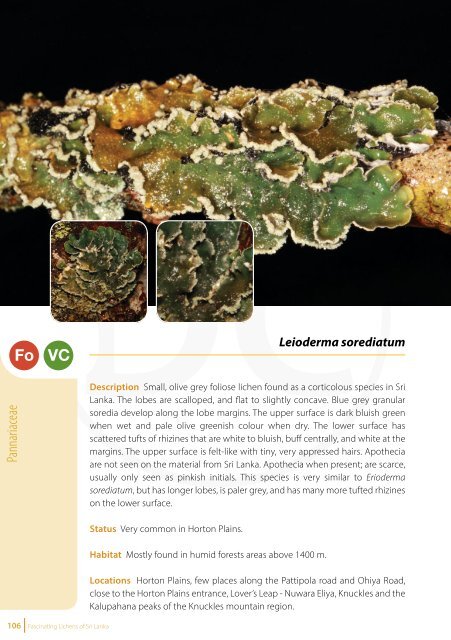Create successful ePaper yourself
Turn your PDF publications into a flip-book with our unique Google optimized e-Paper software.
Leptogium<br />
Jellyskin lichens, Vinyl lichens<br />
Peltigerales Collemataceae<br />
180<br />
Leptogium is most common in the tropical regions <strong>of</strong> the world but is widely<br />
distributed in warm and cool temperate regions and has a few species which<br />
reach the Arctic and Sub-Antarctic regions. It is found on bark, soil, rocks or<br />
mosses in very wet or dry habitats.<br />
This is a very conspicuous and common genus found in most natural and<br />
disturbed habitats in the various climatic regions <strong>of</strong> <strong>Sri</strong> <strong>Lanka</strong>. More than 20<br />
species are known from <strong>Sri</strong> <strong>Lanka</strong> in this genus. Some species are widely spread<br />
across the island. Few recent collections were studied by Gothamie Weerakoon<br />
and Andre Aptroot. Five new records <strong>of</strong> Leptogium were discovered for <strong>Sri</strong><br />
<strong>Lanka</strong> including one species that is a new record for the Indian subcontinent<br />
(Weerakoon & Aptroot 2014). It is probable that many undiscovered species<br />
could occur in particular montane communities. Therefore, further study is<br />
required to discover the total diversity.<br />
Pannariaceae<br />
Fo<br />
VC<br />
Leioderma sorediatum<br />
Description Small, olive grey foliose lichen found as a corticolous species in <strong>Sri</strong><br />
<strong>Lanka</strong>. The lobes are scalloped, and flat to slightly concave. Blue grey granular<br />
soredia develop along the lobe margins. The upper surface is dark bluish green<br />
when wet and pale olive greenish colour when dry. The lower surface has<br />
scattered tufts <strong>of</strong> rhizines that are white to bluish, buff centrally, and white at the<br />
margins. The upper surface is felt-like with tiny, very appressed hairs. Apothecia<br />
are not seen on the material from <strong>Sri</strong> <strong>Lanka</strong>. Apothecia when present; are scarce,<br />
usually only seen as pinkish initials. This species is very similar to Erioderma<br />
sorediatum, but has longer lobes, is paler grey, and has many more tufted rhizines<br />
on the lower surface.<br />
In the field, this genus is difficult to distinguish from its sister genus Collema as<br />
they have much in common, especially when their thalli are moist and swollen.<br />
On the whole, Leptogium species are steel grey to grey or more reddish brown<br />
when dry, with a smoother, more skin-like texture. Collema is never shiny in dry<br />
or wet conditions, probably because it has no upper cortex.<br />
Apothecia lecanorine, sessile, common in most species after rainy seasons, disc<br />
orange-red, red brown to black; Asci: 4-8-spored; Spores: colourless, 4-celled<br />
to muriform.<br />
Chemistry All reactions negative.<br />
Collemataceae<br />
Status Very common in Horton Plains.<br />
Habitat Mostly found in humid forests areas above 1400 m.<br />
Locations Horton Plains, few places along the Pattipola road and Ohiya Road,<br />
close to the Horton Plains entrance, Lover’s Leap - Nuwara Eliya, Knuckles and the<br />
Kalupahana peaks <strong>of</strong> the Knuckles mountain region.<br />
106 <strong>Fascinating</strong> <strong>Lichens</strong> <strong>of</strong> <strong>Sri</strong> <strong>Lanka</strong><br />
<strong>Fascinating</strong> <strong>Lichens</strong> <strong>of</strong> <strong>Sri</strong> <strong>Lanka</strong> 107















